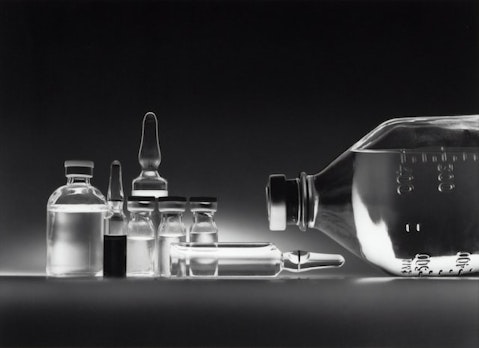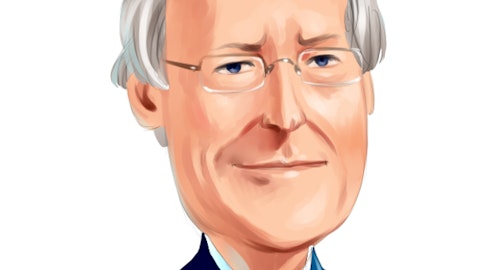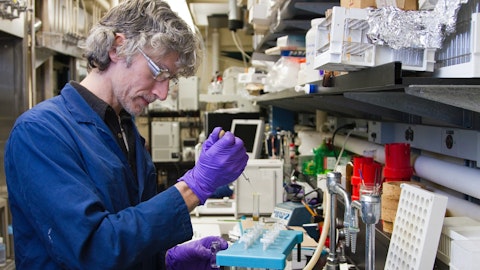Acasti Pharma Inc. (NASDAQ:ACST) Q2 2023 Earnings Call Transcript November 14, 2022
Operator: Good day, and welcome to the Acasti Pharma Second Quarter 2023 Earnings Event Call. All participants will be in listen-only mode. After today’s presentation, there will be an opportunity to ask questions. Please note this event is being recorded. I’d now like to turn the conference over to Robert Blum with Lytham Partners. Please go ahead.

Photo by National Cancer Institute on Unsplash
Robert Blum: All right. Thank you very much. Welcome to Acasti Pharma’s second quarter fiscal 2023 conference call. On the call with us this afternoon is Jan D’Alvise, President and CEO; Brian Ford, Chief Financial Officer; Monique Champagne, VP of Clinical Affairs; and Prashant Kohli, Chief Commercial Officer. Following management’s prepared remarks, there will be a Q&A session. Should any questions remain after the call, please contact me at 602-889-9700. I’d also like to remind everyone that statements on this conference call that are not statements of historical or current facts constitute forward-looking information within the meaning of the Canadian Securities Laws and forward-looking statements within the meaning of the U.S. Private Securities Litigation Reform Act of 1995 and the Securities and Exchange Act of 1934.
Such forward-looking statements involve known and unknown risks and uncertainties that could cause the actual results to be materially different from those expressed or implied by such forward-looking statements. In addition to statements, which explicitly describe such risks and uncertainties, listeners are urged to consider statement labeled with terms belief, expects, intends, anticipates, potential, should, may, will plans, continue, targeted or other similar expressions to be uncertain and forward-looking. Listeners are cautioned not to place undue reliance on these forward-looking statements, which speak only as of the date of this conference call. Forward-looking statements during this conference call may include but are not limited to the success and timing of regulatory submissions of the planned Phase 3 study for GTX-104 and Acasti’s other preclinical and clinical trials, regulatory requirements or developments in the outcome of meetings with the FDA, changes to clinical trial designs and regulatory pathways, legislative, regulatory, political, and economic developments and costs associated with Acasti’s clinical trials.
The forward-looking statements made during this conference call are expressly qualified in their entirety by the cautionary statements. The cautionary note regarding forward-looking information section and the risk factors contained in documents that have been filed and are filed by Acasti from time to time with the Securities and Exchange Commission and Canadian securities regulators, which are available on EDGAR at www.sec.gov on SEDAR at www.sedar.com and on the Investors section of Acasti’s website at www.acastipharma.com. In addition any forward-looking statements represent Acasti’s views as of today and should not be relied upon as representing our views of any subsequent date. Acasti undertakes no obligation to update such statements to reflect events that occur or circumstances that exist after the date in which they were made except as required by applicable securities law.
I’d now like to turn the call over to Jan D’Alvise, President and CEO of Acasti Pharma. Jan, please proceed.
Jan D’Alvise: Thank you, Robert, and thank you, everyone, for joining the call today. We’re really excited to update you on the significant progress made during the second fiscal quarter to advance our three clinical programs. We remain on track to initiate and enroll the first patient in our Phase 3 safety study for GTX-104 in the first half of calendar 2023. This is a key milestone for the company and was expected to be the final clinical step required to seek regulatory approval. As a reminder, GTX-104 is our most advanced clinical program focused on developing and commercializing a novel aqueous formulation of nimodipine for continuous IV infusion to treat patients suffering from Subarachnoid Hemorrhage or SAH. I’ll go into more details in a moment on upcoming timelines and the overall business opportunity for this program.
Also during the second fiscal quarter, we initiated two PK bridging studies, one for GTX-102, our novel concentrated oral mucosal spray of betamethasone, intended to improve the neurodegenerative symptoms of Ataxia Telangiectasia or AT in pediatric patients. And one for GTX-101, our non-narcotic topical bio adhesive film-forming bupivacaine spray designed to treat Postherpetic Neuralgia or PHN. The severe and often debilitating nerve pain that can persist following the shingles infection caused by the varicella zoster virus, the same virus that causes Chickenpox. The GTX-102 PK studies expected to be completed with top line results reported before year end. With positive results from this study, we expect to initiate our Phase 3 program in children with AT and the second half of calendar 2023.
The GTX-101 single dose PK study is also expected to be completed by the end of calendar 2022 and is expected to provide important information on the dosing strength and frequency ahead of the initiation of additional clinical studies of GTX-101 in humans planned next year. I’ll dive deeper into planned activities and the overall opportunities for both GTX-102 and GTX-101 in a moment. Perhaps most important in today’s environment is that we finished the second fiscal quarter ending September 30, 2022 with about $35 million in cash, cash equivalents and short term investments. Based on current projections we believe this is sufficient capital to continue to fund operations through at least March of 2024 and will fund the advancement of GTX-104 well into Phase 3 and allow us to advance GTX-102 and 101 to additional key inflection points.
Taking a step back and as a reminder, our strategy is to leverage the company’s drug delivery technologies and capabilities to reformulate and repurpose marketed drugs for new orphan indications where a significant unmet medical need exists. The well understood efficacy and safety profiles of these marketed compounds provide the opportunity for us to utilize the FDA’s Section 505(b)(2) regulatory pathway for the development of our reformulated drug candidates and therefore may potentially provide a shorter less risky and less costly path to regulatory approval. For those not familiar under Section 505(b)(2) if sufficient support of a product safety and efficacy can be established either through previous FDA experience or sufficiently within the scientific literature, it may eliminate the need to conduct some of the preclinical and clinical studies that new drug candidates might otherwise require under the 505(b)(2) (ph) pathway.
And as I’ve mentioned before, all three of our drug candidates have already received orphan drug designation from the FDA and have the potential to be considered for Fast Track review and approval. Orphan Drug Designation provides for seven years of marketing exclusivity in the United States post launch provided certain conditions are met and 10 years in Europe. These rare diseases also typically involve clinical trials with fewer patients and provide market opportunities that often require a much smaller, more targeted commercial infrastructure. It’s important to point out that the orphan diseases that Acasti has targeted for drug development are well understood, although these patient populations may remain poorly served by available therapies or for example, in the case of our GTX-102 for children with AT, approved drug therapies do not yet exist.
Our aim is to effectively treat the debilitating symptoms that result from these underlying diseases with the ultimate goal of improving quality of life and outcomes for these patients and their families. We believe that leveraging the Section 505(b)(2) regulatory pathway for the development of our reformulated versions of these drugs provides us with highly attractive opportunities in orphan disease indications with little or no current competition. Okay. So let me now circle back to GTX-104 and I’ll update you on the upcoming timelines, milestones and what we see is the overall commercial opportunity. As I mentioned, GTX-104 is a novel formulation of nimodipine for IV infusion designed specifically for patients with subarachnoid hemorrhage or SAH, which is a condition caused by bleeding on the brain due to a ruptured aneurysm.
SAH presents a life threatening emergency for the patient and our new proprietary IV drug formulation addresses a vital need in the critical care market that has seen little innovation in over 30 years. The condition of SAH patients is so critical that 10% to 15% of them die before they ever reach the hospital and only about one-third ultimately survive. Another third of these patients require dependent care for the rest of their lives. So to help address this very severe condition, we completed a Phase 1 PK bridging study in May of 2022, which successfully met all of its endpoints. The primary objective of this study was to evaluate the relative bio availability of our IV GTX-104 compared to oral nimodipine capsules in healthy adult male and female subjects.
While the secondary objective was to assess its safety and tolerability. Importantly, the inter and intra subject variability was much lower for GTX-104 as compared with oral nimodipine. We believe that because of its better absorption profile, and more consistent blood levels. GTX-104 may provide physicians with a more reliable and effective treatment for patients with SAH. This could be a key advantage as GTX-104 could help to reduce the incidence of hypertensive events and vasospasm, which require immediate and costly intervention such as balloon angioplasty, or the use of intra-arterial vasopressors, which can lead to a worse outcome for the patient. We’ve submitted a letter to the FDA to request a Type C meeting to review and discuss the results of the PK bridging study and our proposed design for the Phase 3 safety study As we believe it’s important to obtain the FDA’s feedback and guidance before initiating the Phase 3 safety study, next year.
We expect to meet with the FDA by early January 2023, which should allow us to initiate the Phase 3 safety study and enroll the first patient according to plan in the first half of 2023. As mentioned, the Phase 3 safety study is expected to be the final step required to seek regulatory approval before submitting a new drug application to the FDA for GTX-104 for the treatment of SAH patients. We’re extremely excited about the opportunity to bring a new treatment option to patients that suffer from the SAH, with an estimated 50,000 patients per year in the United States alone. Based on our market research, we believe that GTX-104 represents a total available market in the U.S. of more than $300 million. The current standard of care is an orally administered drug called nimodipine, which is approved by the FDA way back in 1988.
Nimodipine is a potent calcium channel blocker that relaxes the blood vessels in the brain and lowers blood pressure to allow more oxygenated blood into the brain to enhance healing. It’s typically given throughout the entire period that the patient remains in the hospital which can be up to three to four weeks or sometimes even longer depending on the severity of the patient’s condition. Nimodipine is available in the U.S. as an orally administered capsule or liquid, which is problematic as many of these SAH patients are not conscious or if they’re awake, they have a hard time swallowing oral drugs. Consequently, nimodipine often must be delivered via a nasogastric tube and the drug can stick to the inside of the tube, which can result in significant variability in dosing.
Oral nimodipine is also poorly absorbed adding to the difficulty in controlling the blood pressure of the patient. For these reasons, physicians sometimes must reduce the dose or discontinue nimodipine altogether, meaning the patient will not get the full benefit of the drug. We believe that GTX-104 delivered intravenously could be a game changer as a more convenient efficient and precise way to deliver nimodipine directly into the patient’s bloodstream. Okay. Let’s transition now to GTX-102 and I’ll start with a brief program overview. GTX-102 is a novel concentrated oral mucosal spray a betamethasone intended to improve the neurological symptoms of Ataxia Telangiectasia or AT, for which there are currently no FDA approved therapies. AT is a progressive genetic neurodegenerative disorder that primarily affects young children, causing severe disability, impairment of the immune system and an increasing susceptibility to infections and cancers.
Patients typically die in their mid-20s from complications of lung, lung effects and effects approximately 4,300 patients per year in the United States. And based on the number of treatable patients, has a potential addressable market of about 150 million. GTX-102 is comprised of a proprietary concentrated formulation of the glucocorticoid steroid betamethasone that can be sprayed conveniently over the tongue of the AT patient who often have difficulty swallowing. As I mentioned a moment ago, we initiated a Phase 1 PK bridging study in the third calendar quarter of 2022 to evaluate the comparative bioavailability pharmacokinetics and safety of our oral betamethasone spray, GTX-102 compared to an intramuscular injection of betamethasone, the reference drug and to an oral solution of betamethasone in 48 healthy subjects.
The first subject first dose was administered on September 13, 2022. This PK study is the next step in the clinical development pathway for GTX-102 and is expected to be completed with top line results reported before calendar year end. I look forward to sharing more with everyone in the coming weeks on this important study. And finally, let’s discuss the progress that our team has made on GTX-101, our novel non-narcotic thin film, bio adhesive topical bupivacaine spray designed to treat PHN, the severe and often debilitating nerve pain that can persist following the shingles infection. It’s important to point out that market studies suggest a significant unmet need exists for treating these patients with PHN. Approximately 40% of patients who are prescribed the standard of care, which includes oral gabapentin and lidocaine patches experienced, insufficient pain relief and gabapentin has unpleasant side effects.
Consequently, many of these patients ended up being prescribe more potent drugs such as opioids, which can be addictive. The potential benefit of GTX-101 could include faster onset of action, which is inherent in our active ingredient, bupivacaine versus lidocaine, as well as a longer duration of pain relief. GTX-101 can be conveniently sprayed on the skin wherever the pain is located. And based on the PK — the PKA schedule will need to be confirmed in our clinical trials. We believe GTX-101 has a tends to be a disruptive therapy as a non-opioid analgesic for PHN patients who suffer from this debilitating pain. On July 26, 2022, we initiated the PK bridging study to evaluate the relative bioavailability of GTX-101 compared to the reference listed drug bupivacaine in 48 healthy subjects.
The PK study is the next step in our clinical development pathway for GTX-101. The PK study is expected to be completed by the end of calendar 2022 as planned and is expected to provide important information on the dose and dosing frequency for additional clinical studies of GTX-101 in humans in 2023. I look forward to sharing more with everyone in the coming weeks on this study. So let me recap quickly before I turn it over to Brian for a quick review of our Q2 numbers. First, we expect to receive guidance from the FDA on our proposed Phase 3 safety study design for GTX-104 in the form of a Type C meeting no later than early in the first calendar quarter of 2023. This should allow us to initiate a Phase 3 safety study and begin enrolling the first patient as planned in the first half of 2023.
The study is expected to take about 18 months to complete and is expected to be the final clinical step required to seek approval under the 505 (b) (2) regulatory pathway. The PK bridging study of GTX-102 was initiated on September 13, 2022, and we expect to report out top line results on schedule next month before the end of calendar 2022. Assuming the PK bridging study meets its primary endpoint, we expect that the final development step is to conduct a Phase 3 safety and efficacy trial in AT patients. We plan to request a Type B meeting with the FDA following the completion of the PK study to confirm that Phase 3 study design and the Phase 3 study is expected to be initiated in the second half of 2023. If both studies meet their primary endpoints and NDA filing for GTX-1012 or under Section 505 (b) (2) would follow.
The single dose study of GTX-101 was initiated on July 26, 2022 in healthy human volunteers. This PK study is the next step in our proposed 505 (b) (2) regulatory pathway for GTX-101 and the PK study is expected to be completed by the end of calendar 2022 as planned and should provide important information on the dose and dosing frequency for additional clinical studies of GTX-101 in humans in 2023. And finally, it’s important to note that we finished the second fiscal quarter ending September 30, 2022 with about $35 million in cash, cash equivalents and short term investments We continue to believe that this is sufficient capital to fund operations through at least March of 2024, allowing for the advancement of 104 well into Phase 3 and advancing GTX-102 and 101 to key value inflection points.
We’re very excited about the prospects ahead for the company and we look forward to keeping you apprised of our progress towards our many milestones this new fiscal year. I’d like to now turn the call over to Brian Ford, our CFO, to review our financial results. And at the conclusion of Brian’s remarks, we’ll open the call for your questions. Brian?
See also 10 Chamath Palihapatiya Stocks and 12 Best Beaten Down Stocks To Buy.
Brian Ford: Thanks, Jan. Please note that unless otherwise indicated, all financial numbers that we discuss are denominated in U.S. dollars and the financials are reported conforming to U.S. GAAP guidelines. We should also note that we are a clinical stage company thus, we do not yet generate revenues or have any cost of goods expenses. Research and development expenses net of government assistance for the three months ended September 30, 2022, totaled $3.3 million compared to $0.6 million for the three months ended September 30, 2021. Our research and development during quarter ended September 30, 2022 focused primarily on advancing our clinical development programs for our GTX-104, 102 and 101 drug candidates. General and administrative expenses for the quarter ended September 30, 2022 were $1.6 million compared to $2.9 million for the quarter ended September 30, 2021.
This decrease was the result of decreased legal, tax counting and other professional fees that we incurred in connection with the Grace merger . The decrease in professional fees was partially offset by an increase in salaries and benefits due to the renewed accrual for our employee incentive bonus program. Loss from operating activities for the quarter ended September 30, 2022 was $5.1 million compared to $3.6 million loss for the quarter ended September 30, 2021. Net loss and total comprehensive loss for the quarter ended September 30, 2022 was $4.9 million or $0.11 loss per share compared to net income of $1 million or $0.03 per share income of $0.03 per share for the quarter ended in 2021. Cash, cash equivalents and short term investments totaled $34.9 million as of September 30, compared to $43.7 million in cash, cash equivalents and short-term investments as at March 31, 2022.
As Jan mentioned, we will continue to believe that we have sufficient capital to fund operations through at least March of 2024, which will include the ability to fund our lead asset GTX-104 well into Phase 3 and GTX-102 and 105 to additional milestones. With that, I’ll now turn the call back over to Jack.
Jan D’Alvise: Thanks, Brian. Before I turn it over to the operator for questions, I wanted to let everyone know we’ll be participating in the Investor Summit Conference tomorrow. If we don’t already have a one-on-one meeting scheduled with you and you would like to arrange a meeting with us, please reach out to Robert Blum and he can coordinate getting a meeting scheduled. With that, I’d like to now turn the call over to the operator. Jason, can you open it up for questions?
Q&A Session
Follow Acasti Pharma Inc. (NASDAQ:ACST)
Follow Acasti Pharma Inc. (NASDAQ:ACST)
Operator: Yes. Thank you. We will now begin the question-and-answer session. Our first question comes from Leland Gershell from Oppenheimer. Please go ahead.
Leland Gershell: Hey. Good afternoon and thanks for taking my questions. Just a question on 104, I know it’s sometime away, but just as you think about approaching the commercial market for the opportunity in SAH to access those patients out there in hospitals and ICUs and so forth. What structure do you plan to deploy in terms of commercial organization and field reps if you’re able to speak to that? Thanks.
Jan D’Alvise: Yes. Thank you, Leland. Thanks for being on the call today. Yes, the really nice thing about this market is that it’s highly concentrated. These patients present typically to a major healthcare center with usually a stroke — ICU stroke unit. And there’s about roughly 1,400 of those centers around the country. It’s interesting because it’s a typical 80/20 rule or in this case about 70% actually of the patients are treated in about 400 of those centers. So we really believe that we can commercialize GTX-104 ourselves. And we think we can do this initially with just roughly 15 to 20 reps and then grow organically as sales growth. So we obviously would be targeting some of the larger centers around the country. And I should mention by the way that we already have relationships with many of these centers.
We expect a number of them to participate in our Phase 3 safety study and will be recruiting patients for us. So if we have a successful study and the drug gets approved, we would expect fairly rapid adoption. I should mention that we remain open to other potential partnering opportunities not just in the U.S. but certainly outside of the U.S. we think there’s really in a very attractive market, for example, in China. So we have discussions just beginning for potential partnership opportunities in Asia as well as potentially in Europe as well.
Leland Gershell: Thank you and great. And just to confirm, so we’ll see the 102, it sounds like sometime next month so we look forward to seeing that readout. Thanks very much for taking the questions.
Jan D’Alvise: Yeah. Sorry, I didn’t catch the last part you cut out there. Were you asking about 102?
Leland Gershell: Yeah. Just confirming that we’ll see the top line by year end.
Jan D’Alvise: Yes, absolutely. Yeah. We’re planning to report out that study — we should have the top line results before the end of December. So we will report that out as soon as we get the results.
Leland Gershell: Great. Look forward to it. Thanks so much.
Jan D’Alvise: Yeah. Thanks, Leland.
Operator: Our next question comes from Sahil Kazmi (ph) from B. Riley Securities. Please go ahead.
Sahil Kazmi: Yeah. Thank you. Good afternoon, Jan and team and congratulations on another productive quarter, and thanks for taking our questions. Just have a couple here. Maybe if we can start with something that you were going over and the recap there. Could you just remind us when we can expect sort of potential filings for each of the programs, and then sort of lay in your current balance sheet and capital requirements to that in the context of during the time of the 104 filing, I know the runway sufficient through there, but for the other programs as well.





